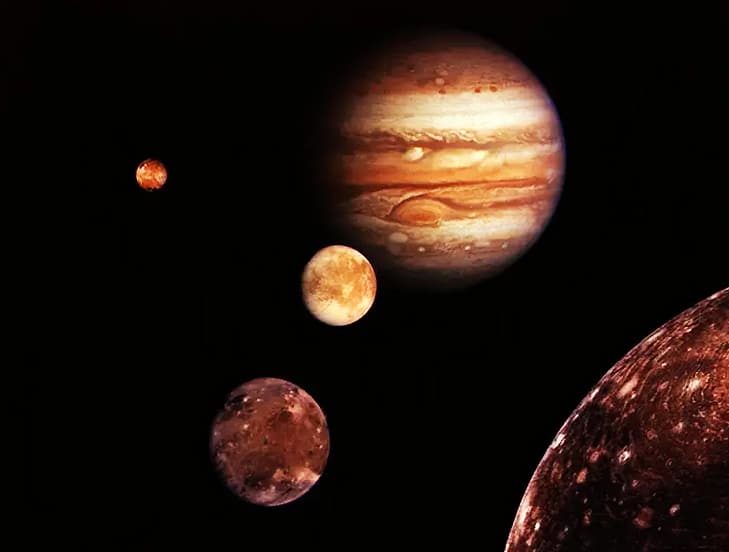 Jupiter’s four largest moons, Io, Europa, Ganymede, and Callisto, are shown in their relative positions to each other and Jupiter. A new study argues that these moons may have a bigger influence on each other’s tides than Jupiter has, contrary to popular thought. Courtesy/NASA/JPL
Jupiter’s four largest moons, Io, Europa, Ganymede, and Callisto, are shown in their relative positions to each other and Jupiter. A new study argues that these moons may have a bigger influence on each other’s tides than Jupiter has, contrary to popular thought. Courtesy/NASA/JPL
AGU News:
A new study argues that Jupiter’s four largest moons may have a bigger influence on each other’s tides than Jupiter itself does.
The findings suggest that oceans on these moons could then generate more heat from friction and could be more suitable to hosting life than previously thought.
Jupiter is the largest planet in the solar system, so it stands to reason that it would have the largest influence on the tides of its ocean moons. But according to the new research, a bigger gravitational tug doesn’t necessarily translate to higher tides if the timing is off.
The new study in AGU’s journal Geophysical Research Letters suggests that Jupiter’s four largest moons, collectively known as the Galilean moons, might play a bigger role in the ebb and flow of each other’s tides than the big planet they orbit does because of a phenomenon called tidal resonance. This newly discovered relationship between the moons means researchers might have to reconsider their understanding of how these ocean moons evolved and where most of their heat is coming from.
Moon-Moon Tides
Previous research suggests that three of Jupiter’s four largest moons (Europa, Ganymede, and Callisto) contain vast liquid water oceans beneath their icy crusts. The fourth moon, Io, might contain an ocean of magma. The oceans of these Galilean moons have tides that rise and fall as they are stretched and squeezed by Jupiter, just as Earth’s oceans are tugged at by our Moon.
Although researchers have long considered the gravitational effects that Jupiter has on its ocean moons, they have until now neglected the potential tides raised by the moons on each other.
The new paper, by researchers with the Lunar and Planetary Laboratory in Tucson, Ariz., argues for the first time that Galilean moons’ gravitational pulls on each other, though smaller, could be producing larger tides than Jupiter does. That’s because they are more tidally resonant with each other.
Resonance is more about timing than size. If you’re pushing someone on a swing, for instance, timing your shove with the natural forward momentum of the swing will ensure their next swing is higher. Jupiter does the gravitational equivalent of giving the swing a big push when it’s coming at you, whereas the moons give each other the equivalent of little pushes on the upswing.
According to Hamish Hay, lead author of the new study and now a postdoctoral fellow at NASA’s Jet Propulsion Laboratory in Pasadena, Calif., for Jupiter to produce dramatic tides on its moons, the planet would have to be tidally resonant with the oceans of those moons.
In the new study, Hay and his colleagues calculated how tidal forces of Jupiter and other moons would affect the flow of oceans of different depths. For Europa, for instance, they assumed an ice shell 10 kilometers (6 miles) thick.
They found that Jupiter’s pull could raise a tidal wave if Europa’s ocean were just 200 meters (660 feet) thick, which researchers think is unlikely. Io’s weaker gravitational influence, on the other hand, could induce a sizable westward tidal wave in oceans up to 80 kilometers (50 miles) thick. The researchers saw this trend for all the Galilean satellites, with moon-moon tides capable of producing many times more heat than Jupiter’s tidal forces could possibly generate.
“That’s kind of interesting, because Jupiter is the biggest mass in that system, so its tidal forces are much bigger than one moon on another,” Hay said.
Absent tidal resonance, most of the heat within these oceans would be generated from radioactive decay of elements and Jupiter-raised tides in the rocky portions of the moons. But if dramatic tides due to the other moons are also in play, the ocean could be generating its own heat from friction with the icy shell it’s trapped under. A warmer, more dynamic ocean is one that could potentially be more suitable to life.
Determining Ocean Thickness
Tidal resonance could also help scientists pinpoint exactly how thick the Galilean moons’ oceans are. If the tides under the ice are strong enough, the whole moon’s surface would pulse in and out, as though the moon were breathing.
“If you can measure the rate at which the moon’s surface is moving up and down, then that would be a way to tell you how thick the ocean might be,” Hay said.
However, much of this research is still theoretical, he cautioned. The models used in the paper take only horizontal motion into account, just as they would on Earth. If these oceans are actually over 100 kilometers (60 miles) deep, as most researchers think they are, there would also be a significant amount of vertical motion to account for.
In addition, it isn’t possible to calculate the exact resonant frequency without knowing precisely how thick the moons’ oceans are. Although the moons could have been tidally resonant with each other in the past, they might not be today.
In the future, Hay said, researchers could build on this work by modeling the way the oceans and their icy shells evolved together on these moons in light of the potential for tidal resonance. This could completely change scientists’ views of the history of Galilean moons, Hay said. (Geophysical Research Letters, https://doi.org/10.1029/2020GL088317, 2020)

